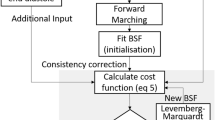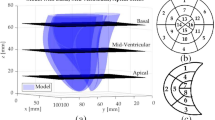Abstract
Purpose
Ultrasound (US) is the state of the art in prenatal diagnosis to depict fetal heart diseases. Cardiovascular magnetic resonance imaging (CMRI) has been proposed as a complementary diagnostic tool. Currently, only trigger-based methods allow the temporal and spatial resolutions necessary to depict the heart over time. Of these methods, only Doppler US (DUS)-based triggering is usable with higher field strengths. DUS is sensitive to motion. This may lead to signal and, ultimately, trigger loss. If too many triggers are lost, the image acquisition is stopped, resulting in a failed imaging sequence. Moreover, losing triggers may prolong image acquisition. Hence, if no actual trigger can be found, injected triggers are added to the signal based on the trigger history.
Method
We use model checking, a technique originating from the computer science domain that formally checks if a model satisfies given requirements, to simultaneously model heart and respiratory motion and to decide whether respiration has a prominent effect on the signal. Using bounds on the physiological parameters and their variability, the method detects when changes in the signal are due to respiration. We use this to decide when to inject a trigger.
Results
In a real-world scenario, we can reduce the number of falsely injected triggers by 94% from more than 87% to less than 5%. On a subset of motion that would allow CMRI, the number can be further reduced to below 0.2%. In a study using simulations with a robot, we show that our method works for different types of motions, motion ranges, starting positions and heartbeat traces.
Conclusion
While DUS is a promising approach for fetal CMRI, correct trigger injection is critical. Our model checking method can reduce the number of wrongly injected triggers substantially, providing a key prerequisite for fast and artifact free CMRI.










Similar content being viewed by others
References
Alnuaimi SA, Jimaa S, Khandoker AH (2017) Fetal cardiac doppler signal processing techniques: challenges and future research directions. Front Bioeng Biotechnol 5:82
Alur R, Dill DL (1994) A theory of timed automata. Theor Comput Sci 126(2):183–235
Antoni ST, Rinast J, Ma X, Schupp S, Schlaefer A (2016) Online model checking for monitoring surrogate-based respiratory motion tracking in radiation therapy. Int J Comput Assist Radiol Surg 11(11):2085–2096
Baier C, Katoen JP (2008) Principles of model checking. The MIT Press, London
Cimatti A (2001) Industrial applications of model checking. Springer, Berlin, pp 153–168
Dürichen R, Wissel T, Ernst F, Schlaefer A, Schweikard A (2014) Multivariate respiratory motion prediction. Phys Med Biol 59(20):6043–6060
Ernst F (2012) Compensating for quasi-periodic motion in robotic radiosurgery. Springer, New York
Ferreira PF, Gatehouse PD, Mohiaddin RH, Firmin DN (2013) Cardiovascular magnetic resonance artefacts. J Cardiovasc Magn Reson 15(1):41
Firpo C, Hoffman JI, Silverman NH (2001) Evaluation of fetal heart dimensions from 12 weeks to term. Am J Cardiol 87(5):594–600
Frauenrath T, Hezel F, Renz W, d’Orth TdG, Dieringer M, von Knobelsdorff-Brenkenhoff F, Prothmann M, Schulz Menger J, Niendorf T (2010) Acoustic cardiac triggering: a practical solution for synchronization and gating of cardiovascular magnetic resonance at 7 Tesla. J Cardiovasc Magn Reson 12:67
Hornberger LK, Sahn DJ (2007) Rhythm abnormalities of the fetus. Heart (Br Card Soc) 93(10):1294–1300
Jansz MS, Seed M, van Amerom JFP, Wong D, Grosse-Wortmann L, Yoo SJ, Macgowan CK (2010) Metric optimized gating for fetal cardiac MRI. Magn Reson Med 64(5):1304–1314
Kording F, Ruprecht C, Schoennagel B, Fehrs K, Yamamura J, Adam G, Goebel J, Nassenstein K, Maderwald S, Quick HH, Kraff O (2017) Doppler ultrasound triggering for cardiac MRI at 7T. Magn Reson Med 74:1291
Kording F, Tavares de Sousa M, Yamamura J, Kladeck M, Gerhard A, Ruprecht C, Schoennagel B (2016) Funktionelle fetale kardiale MRT Bildgebung basierend auf Doppler-Ultraschall: Erste Erfahrungen. Fortschr Röntgenstr 188(S 01):RK205\_2
Nacif MS, Zavodni A, Kawel N, Choi EY, Lima JAC, Bluemke DA (2012) Cardiac magnetic resonance imaging and its electrocardiographs (ECG): tips and tricks. Int J Cardiovasc Imaging 28(6):1465–1475
Paley MNJ, Morris JE, Jarvis D, Griffiths PD (2013) Fetal electrocardiogram (fECG) gated MRI. Sensors (Basel, Switzerland) 13(9):11,271–11,279
Seeger A, Fenchel MC, Greil GF, Martirosian P, Kramer U, Bretschneider C, Doering J, Claussen CD, Sieverding L, Miller S (2009) Three-dimensional cine MRI in free-breathing infants and children with congenital heart disease. Pediatr Radiol 39(12):1333–1342
Sievers B, Wiesner M, Kiria N, Speiser U, Schoen S, Strasser RH (2011) Influence of the trigger technique on ventricular function measurements using 3-Tesla magnetic resonance imaging: comparison of ECG versus pulse wave triggering. Acta Radiol (Stockholm, Sweden: 1987) 52(4):385–392
Untenberger M, Tan Z, Voit D, Joseph AA, Roeloffs V, Merboldt KD, Schätz S, Frahm J (2016) Advances in real-time phase-contrast flow MRI using asymmetric radial gradient echoes. Magn Reson Med 75(5):1901–1908
van Amerom JFP, Lloyd DFA, Price AN, Kuklisova Murgasova M, Aljabar P, Malik SJ, Lohezic M, Rutherford MA, Pushparajah K, Razavi R, Hajnal JV (2018) Fetal cardiac cine imaging using highly accelerated dynamic MRI with retrospective motion correction and outlier rejection. Magn Reson Med 79(1):327–338
Yamamura J, Kopp I, Frisch M, Fischer R, Valett K, Hecher K, Adam G, Wedegartner U (2012) Cardiac MRI of the fetal heart using a novel triggering method: initial results in an animal model. J Magn Reson Imaging JMRI 35(5):1071–1076
Author information
Authors and Affiliations
Corresponding author
Ethics declarations
Conflict of interest
K. Fehrs, F. Kording and C. Ruprecht are the founders of the company northh medical GmbH. The other authors declare that they have no conflict of interest.
Informed consent
For this type of study, formal consent is not required.
Rights and permissions
About this article
Cite this article
Antoni, ST., Lehmann, S., Neidhardt, M. et al. Model checking for trigger loss detection during Doppler ultrasound-guided fetal cardiovascular MRI. Int J CARS 13, 1755–1766 (2018). https://doi.org/10.1007/s11548-018-1832-5
Received:
Accepted:
Published:
Issue Date:
DOI: https://doi.org/10.1007/s11548-018-1832-5




